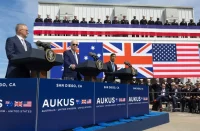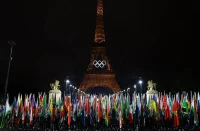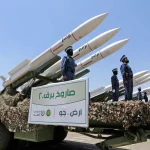The flare ups are not limited by the Middle East region only. The events the world attention was focused on by the end of September made one more hot spot appear on the world map – an escalating dispute over the Senkaku islands claimed by China and Taiwan. The disputed territory is eight uninhabited islands and rocks, a total area of about 7 sq. km. lying east of the Chinese mainland and southwest of Japan’s southern prefecture Okinawa close to major shipping lanes. Japan calls them Senkaku, China calls them Diaoyu and Taiwan calls them Diaoyutai. In 1968 it was reported the islands were rich in hydrocarbons. Japan incorporated them into Japanese territory in 1895. After World War II it renounced claims to a number of territories according to the 1951 Treaty of San Francisco. In accordance with the treaty the islands came under US trusteeship and were returned to Japan in 1971 in line with the Okinawa reversion deal. Japan says Beijing raised no objections back then. China points out that the Diaoyu islands have been part of its territory since ancient times serving as important fishing grounds administered by the province of Taiwan. Taiwan was ceded to Japan by the Treaty of Shimonoseki in 1895 after the Sino-Japanese war. So when Taiwan was returned to China according to the Treaty of San Francisco, it should have been done together with the islands because they were part of it. Kuomintang leader Chiang Kai-shek did not raise the issue being too much dependent on the US for support.

Japan has administered the islands since the US abandoned its control over the Senkaku in 1972 along with Okinawa. Still, it has left them undeveloped although the surrounding waters are believed to hold significant gas reserves. The Japanese government claims that they will get rid of their nuclear stations by 2030. That means Japan would be in great need of natural resources and the Senkaku could provide what the country needs so much. In September Japan bought the islands to prevent them from falling under the nationalist governor of Tokyo who threatened to goad China by buying and developing them. Beijing decried the Japan’s move as a flagrant wrongdoing, trampling on the UN charter and an attempt to challenge international order. In recent weeks a wave of anti-Japanese riots has hit the country. Fishing boats and patrol vessels from China and Taiwan have entered territorial waters to protest the announced nationalization. No injuries as yet, but China has vowed to continue entering Japanese-controlled waters to press its claims. There has been unofficial talk of war. But it should be noted the Chinese government keeps away from using hostile language and emphasizes the fact it remains in dialogue with Japan on the issue.
Military Balance
The military assessment excludes armies. The islands are too small for ground formations to be deployed and conduct combat actions while the amphibious potentials of the both sides exclude wide scale landing operations on the other side’s mainland. Even if an amphibious operation takes place, the landing force will have no chance to survive under heavy air and ground forces strikes. Thus it’s the air forces and navies that the assessment is focused on. It should be noted the countries have the navies second only to the one of the USA.
The Japanese Air Force inventory numbers 375 combat aircraft. There are plans to acquire 42 F-35 fifth generation fighters from the USA but there is no definite decision on the timing of the deal. The Navy operates some 110 major warships including 17 submarines, 4 four helicopter destroyers (helicopter carriers), 38 destroyers, 6 frigates, 6 missile fast patrol boats and 3 tank landing ships. The Aegis equipped Kongo and Atago classes missile destroyers are the most modern ships with enhanced capabilities, including missile defense.
The Chinese Air Force and naval aviation together operate over 2000 combat aircraft. The both services are in the process of getting the latest versions of modern, capable assets instead of the obsolete ones. Totally China possesses 5 times more combat planes than the Japanese Air Force; it has clear advantage concerning strike capability and fighters. The SU-27s, SU-30s and J-11s capabilities match those of F-15Js. It enjoys great superiority in tactical and medium range ballistic missiles, as well as sea, shore and air based cruise missiles enabling it to strike multiple ground targets. In comparison Japan possesses neither ballistic nor cruise missiles. China also has the world’s largest submarine fleet including 8 nuclear attack and around 60 conventional submarines, all of them equipped with cruise missile launchers. The obsolete ones are actively taken out of inventory to be replaced by new ones including 095 type nuclear attack boats. The Shi Lang light aircraft carrier (former Russian Varyag) was commissioned on 25 September 2012. China is expected to build “real” air wing capable carriers in around 10 years. The fleet boasts over 70 major surface combatants. Beijing is developing the Dongfeng-21D, a ballistic missile with a maximum range of 2,700 kilometers and the ability to strike moving targets at sea, including aircraft carriers. The mosquito fleet is really numerous, including about 120 fast attack missile and up to 250 patrol craft. The navy has significant amphibious assault capability with three 20,000-tonne Type 071 Yuzhao-class amphibious transport docks, 30 large and 60 medium size amphibious ships. This capability is useless, however, in the given case for the islands are too small for sea-to-shore landing operations.
As one can see China enjoys significant numerical superiority, especially in submarines and light craft. The weak point is air defense except the 051С and 052С/D type destroyers, but even these assets are no match for the Japanese Aegis equipped surface combatants. The advantages mentioned above are hard to use far from shore. It makes the importance of air power pale in comparison with surface forces where the Chinese superiority in is not so obvious.
The countries have great economic interest in cooperation. The bilateral trade is over 300 billion dollars. In case of full-blown air-sea battle the both sides would suffer great losses including the loss of the most expensive, modern assets and sky high expenditure inflicted as a result of ammunition and fuel consumption. The economic loss is to make pale any advantage of capturing the islands. Trade income lost, it would strike economy really hard. Taiwan would hardly lose the moment to declare independence. Obviously the use of force to settle the dispute over the islands doesn’t meet the interests of neither China nor Japan. No matter who suffers more losses, the outcome will be devastating for the both of them. Of course a fight may spark as a result of unexpected incident, but it’s a far-fetched possibility at present. No matter how the events unfold it’s clear that any shift to “use of force solution” would have only one result – the strengthening of US strategic military and political presence in the Asia-Pacific…
US regional policies
Washington weighed in on the Senkaku dispute. During his last Asia tour in September this year US Defense Secretary Leon Panetta said the security treaty obligating the United States to come to the defense of Japan would be applied to the islands. The view was reiterated by State Department officials. Though China, Japan and Taiwan are members of International Court of Arbitration, somehow the USA doesn’t urge them to base their claims on international law. Looks like Washington prefers to get dragged into the argument instead. If China were to invade the Senkaku islands, the US would have to decide whether to defend them under the US-Japan security treaty. If it did not, Japan and other allies could well conclude that Washington’s security guarantees were worthless. The US has more than 14,000 Marines stationed in Okinawa, many of them veterans of multiple tours of duty in Iraq and Afghanistan. The powerful U.S. 7th Fleet is home ported in Yokosuka, Japan, within easy range of the East China Sea. The US and Japan have recently held a joint military exercise focusing on seizing the islands. US presidential candidate Mitt Romney has just promised to boost warships production to 15 units per year. Naturally the major part of them would be home ported in the Asia-Pacific to boost the country’s military and political clout in the region.
Japan also claims the southern Kuril Islands. The territory is legally a part of Russia. The Soviet Union’s sovereignty over the islands was recognized following the agreements at the end of the Second World War. The Yalta Treaty gave the Soviet Union a right to the Kurils and it upheld its obligations accordingly.
Russia inherited possession of the islands from the former Soviet Union as its successor state in accordance with international law. The Treaty of San Francisco was officially signed by 49 nations, including Japan and the United States, on September 8, 1951. Article (2c) states: “Japan renounces all right, title and claim to the Kurile Islands, and to that portion of Sakhalin and the islands adjacent to it over which Japan acquired sovereignty as a consequence of the Treaty of Portsmouth of 5 September 1905.” The Tokyo’s territorial claim and is not supported by history or geography. Since the early 1960s, however, the Japanese government has unwaveringly claimed all four islands to be Japanese territory. The US supports entirely the Japanese claims over the four disputed islands fuelling even more tension and compounding the efforts for finding a solution. It’s not the details that is important, but rather the US stance on the issue effectively advocating for revision of the outcome of World War II. As in other cases the United States takes sides ignoring the legal aspect of the matter.
Somehow, a plain coincidence or not, the practically dormant, smoldering territorial disputes all of a sudden intensified after Washington announced its new strategy envisaging the “return to Asia”.
Since last year, China and the Philippines, a US ally, have been locked in a territorial dispute over Huanyan Island (Scarborough Shoal) in the South China Sea. There was a joint naval exercise held In April 14 2012 to display the US support for Manila. Meanwhile, the disputes over the Spratlys and some other waters and islands in that sea between Vietnam and China have also soured bilateral relations. Amid the rise of tensions the US demonstratively held its first joint naval exercise with Vietnam in July 2011. The U.S. strategy includes an expansion of training exercises in other parts of the region to include newer participants, such as Cambodia and Malaysia as well as the deployment of new hardware, including littoral combat ships in Singapore and deploying a Marine Corps unit in Australia. The new Asia-pivot strategy also put a stamp on the US-dominated regional free-trade area – the Trans-Pacific Strategic Economic Partnership Agreement (TPP), which excludes China, no matter it’s the biggest economy in the region. If Washington really wanted to be a fair mediator than why should it permanently reprimand China as the only one guilty when territorial disputes occur? If the reason is defending smaller countries against the great global power, than why condemn China for its stand on Iran, Syria or North Korea? And finally, why oppose China and challenge its core interests in the Pacific instead of rationally managing this region’s smoldering conflicts on the basis of international law and cooperating with all other concerned countries so that the USA would be viewed as a fair and responsible mediator, not a troublemaker “returning” to the region?
Source: Strategic Culture Foundation














I agree with the expert. he is right, the flare-ups may happen unwillingly when the tensions are high. Remember WWI, remember how the Vietnam war started? I like the insight on the way the situation may creep on, it’s important to foresee the things to evade the worst.
It’s important the author stresses the role of sea power in the 21 century. I looked up his facebook page – he’s a retired military, I guessed it right at the start. No wonder the realizes it’s all bout islands ot shore situated territories and you need navy to shpore up your foreign policy goals.
@Victoria
We also appreciate Mr.Akulov’s expertise in military affairs and English language. However according to his FB page, he might be even more competent in pets :)